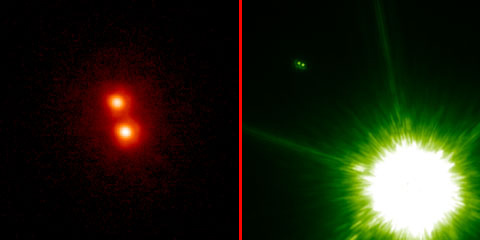More brown dwarf news came out of the last press conference: the masses of some of the lowest mass brown dwarfs have been found using the powerful Keck telescope in Hawaii. They did this by precisely measuring the orbits of binary brown dwarfs, and from the well-known equations of how bodies orbit one another the masses were found.
 |
| Images of the two brown dwarf binary systems from the Keck telescope. Credit: Michael Liu (IfA, U Hawaii) and Trent Dupuy and Michael Liu (IfA, U Hawaii), respectively. |
Amazingly, one binary system (2MASS 1534-2952AB) appears to be comprised of two brown dwarfs each of which have only 3% the mass of the Sun! This makes them the lowest mass and coldest objects (outside of extrasolar planets orbiting other stars) for which a mass has been found. Another binary (HD 130948BC) was measured as well, and each star has a mass of 5.5% the mass of the Sun – and as you can see in the image above, this pair orbits a third star which is more like the Sun, which is why it appears so much brighter.
While this is pretty nifty in and of itself, it gets better when these masses are compared to the theoretical masses of the brown dwarfs derived from the equations expected to describe them, and then looking at the other characteristics of the failed stars. When that’s done, the first pair is cooler than expected, and the second pair warmer! That means the theories need to be tweaked a bit. It’s probably not anything hugely serious, but it’s interesting nonetheless.
Both binaries are about 50 light years from the Earth – if they were much farther away they’d be too hard to study, even with Keck – and in both pairs the stars are separated by about twice the Earth-Sun distance.
Note to my readers: if you like any of these news stories coming out of this meeting, then please feel free to click the yellow Digg button to help spread the word! Thanks.